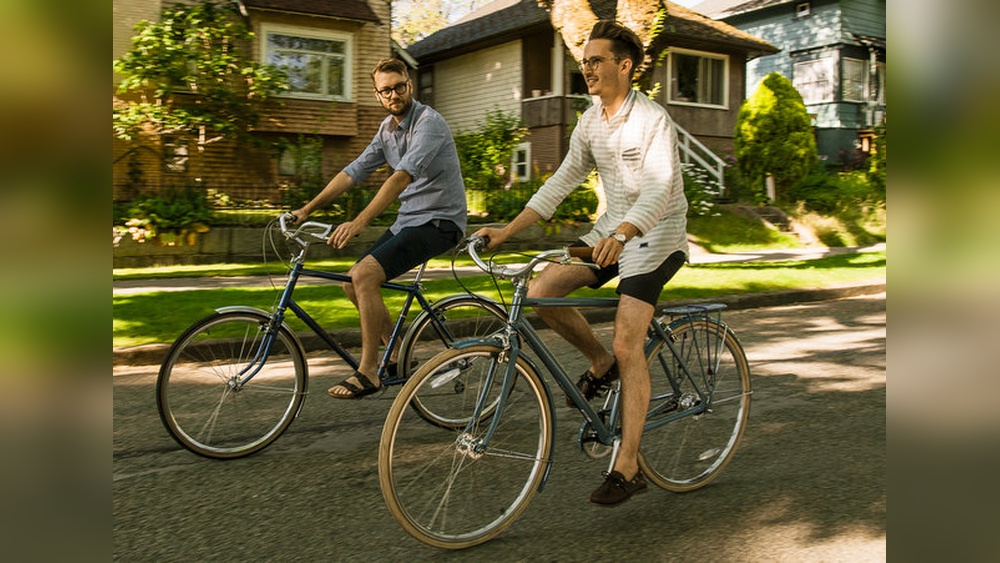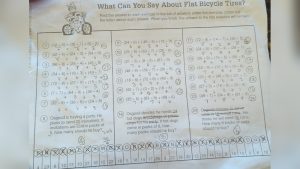Are you tired of ending your long bike rides with sore muscles and stiff joints? Your posture on the bike could be the key to making every ride more comfortable and enjoyable.
Finding the best bicycling posture for long rides isn’t just about looking good—it’s about protecting your body and boosting your performance. You’ll discover simple adjustments that can help you ride farther, feel stronger, and avoid common aches and pains. Keep reading to learn how to transform your cycling experience with the right posture.

Credit: youngelectricbikes.com
Choosing The Right Bike Fit
Choosing the right bike fit is key for long rides. A good fit keeps you comfortable and prevents pain. It also helps you pedal efficiently and avoid injuries. Small changes in your bike setup can make a big difference. Focus on three main areas: frame size and geometry, saddle height, and handlebar positioning.
Frame Size And Geometry
The frame size must match your body height and leg length. A frame too big or small causes discomfort and poor control. Check the bike’s top tube length and seat tube height. The right geometry supports your riding style. Road bikes and mountain bikes have different shapes to suit different needs. Test the bike before buying to find the best fit.
Adjusting Saddle Height
Saddle height affects your pedaling power and knee comfort. Your leg should be slightly bent at the bottom of the pedal stroke. Too high causes hip rocking and pain. Too low reduces pedaling efficiency and strains knees. Use a ruler or bike fit calculator to measure. Adjust slowly and test with short rides. Fine-tune until you feel steady and strong.
Handlebar Positioning
Handlebar height and reach influence your riding posture. Higher bars reduce strain on your back and neck. Lower bars improve aerodynamics but may cause discomfort. Reach should allow a relaxed arm bend. Stretching too far causes shoulder tension. Adjust stem length and handlebar height for comfort. A balanced position helps you ride longer without pain.
Optimizing Saddle Setup
Optimizing your saddle setup is key for a comfortable long ride. The right saddle reduces pain and improves your cycling efficiency. Small changes can make a big difference in how you feel after hours on the bike.
Focus on three main points: saddle type, tilt, and pressure points. Each affects your comfort and posture. Understanding these can help you enjoy longer rides without discomfort.
Selecting Comfortable Saddle Type
Choose a saddle that fits your body shape and riding style. Wide saddles suit casual riders who sit upright. Narrow saddles work better for racers leaning forward. Consider padded saddles for extra comfort on long rides.
Test different saddles if possible. Comfort varies from person to person. Remember, a well-chosen saddle supports your sit bones properly.
Correct Saddle Tilt
Keep your saddle level or tilt it slightly nose down. A level saddle spreads your weight evenly. Too much tilt causes sliding or pressure on sensitive areas. Small adjustments can reduce numbness and pain.
Check saddle tilt regularly. Road bumps and riding style changes might shift it over time.
Preventing Pressure Points
Pressure points cause numbness and soreness. Use padded shorts or gel covers to reduce pressure. Adjust saddle position forward or backward for better weight distribution.
Stand up and pedal during long rides to relieve pressure. Frequent small breaks help blood flow and reduce discomfort.
Proper Hand And Arm Placement
Proper hand and arm placement plays a big role in long rides. It helps keep comfort and control. Holding the handlebars the right way reduces strain on your muscles. It also stops pain and numbness during long trips. Paying attention to how you place your hands and arms can make rides more fun and less tiring.
Grip Positions For Comfort
Different grip positions help change pressure on your hands. Use the drops for speed and control. The hoods give a relaxed grip and good brake access. The tops are best for resting your hands. Switch grips often to avoid soreness. Find the grip that feels natural and steady for you.
Relaxing Shoulders And Arms
Keep your shoulders low and loose. Tense shoulders cause pain and tiredness fast. Let your arms bend slightly at the elbows. This helps absorb bumps from the road. Avoid locking your elbows or gripping the bars too hard. A relaxed upper body keeps you riding longer and stronger.
Avoiding Numbness And Fatigue
Numb hands come from too much pressure on nerves. Change your hand position every 10 to 15 minutes. Use padded gloves to reduce vibrations. Check your handlebar height and reach. Proper bike fit helps spread weight evenly. Listen to your body and adjust to stay comfortable.
Maintaining Core Stability
Maintaining core stability is vital for long rides on a bicycle. The core muscles support your spine and pelvis. Strong core muscles keep your body balanced and steady while cycling. This reduces fatigue and prevents injuries during long hours on the bike.
Engaging Core Muscles
Activate your core by pulling your belly button toward your spine. Hold this engagement without holding your breath. Keep your shoulders relaxed and avoid arching your back. A steady core helps transfer power to the pedals. This makes pedaling easier and more efficient.
Reducing Lower Back Strain
Core strength lowers the pressure on your lower back. Without a strong core, the lower back does extra work. This causes pain and stiffness after long rides. Use your abdominal muscles to support your spine. Keep your hips stable to avoid rocking side to side.
Posture Tips For Spinal Alignment
Keep your spine in a neutral position, not too curved or straight. Imagine a straight line from your head to your hips. Avoid slouching or leaning too far forward. Keep your chin slightly tucked to protect your neck. Aligning your spine reduces muscle tension and improves breathing.
Foot And Pedal Techniques
Foot and pedal techniques are key for comfort and speed on long rides. Proper foot placement reduces pain and boosts power. Efficient pedaling saves energy and keeps your legs fresh. Using cleats and clipless pedals can improve control and pedal stroke. Let’s explore these topics to help you ride better and longer.
Foot Position On Pedals
Place the ball of your foot over the pedal axle. This spot gives the best balance of power and control. Avoid putting weight on your toes or heels. Keep your foot flat and relaxed. This position helps prevent foot numbness and soreness.
Pedaling Efficiency
Push down smoothly, then pull up with your foot. This circular motion uses more muscles. It reduces fatigue during long rides. Keep a steady cadence between 80 and 100 revolutions per minute. This rhythm helps your legs work evenly and saves energy.
Using Cleats And Clipless Pedals
Cleats lock your feet to the pedals for better power transfer. Clipless pedals let you pull up as well as push down. This improves pedaling efficiency and bike control. Start slowly to get used to clipping in and out. Proper adjustment prevents knee pain and discomfort.

Credit: frey.bike
Clothing And Gear For Comfort
Comfort is key for long rides. Wearing the right clothing and gear helps reduce pain and fatigue. It supports your body and makes riding more enjoyable. Choosing the right items protects your skin, cushions pressure points, and keeps you safe.
Good gear also improves your posture. It helps you stay steady and balanced on the bike. This section covers essential clothing and gear for a smooth, pain-free ride.
Choosing Padded Shorts
Padded shorts reduce pressure on your sit bones. The soft padding absorbs shocks from rough roads. It also prevents skin chafing and soreness. Look for shorts with good padding thickness and quality fabric. They should fit snugly but not too tight. Breathable material helps keep you cool and dry.
Gloves For Hand Support
Gloves protect your hands from numbness and blisters. They provide extra grip on the handlebars. Padded gloves cushion your palms and reduce vibration. Choose gloves with breathable fabric to avoid sweaty hands. Proper hand support helps maintain control and comfort during long rides.
Proper Helmet Fit
A well-fitting helmet is vital for safety and comfort. It should sit level on your head, not tilted. The straps must be snug but not tight. A loose helmet moves and distracts you. Look for helmets with good ventilation to keep your head cool. Proper fit reduces strain on your neck and enhances focus.
Adjusting Posture During The Ride
Adjusting your posture during a long bike ride helps keep your body comfortable and prevents pain. Staying in one position for too long can cause stiffness and numbness. Small changes during the ride can make a big difference in how you feel.
Changing Hand Positions
Move your hands to different spots on the handlebars often. This reduces pressure on your wrists and shoulders. Try using the drops, hoods, or tops of the bars. Changing hand position helps blood flow and reduces numbness. It also improves control and balance on the bike.
Stretching Breaks
Stop and stretch every 30 to 60 minutes. Stretch your arms, neck, back, and legs gently. Stretching relaxes tight muscles and increases flexibility. Take deep breaths to help your body recover. Short breaks keep your energy up for longer rides.
Recognizing And Addressing Discomfort
Pay attention to any pain or numbness while riding. Discomfort signals that your posture needs adjustment. Shift your weight or change your seating position. Use cushions or gloves to reduce pressure points. Do not ignore pain; fixing it early prevents injury.

Credit: www.gzsamebike.com
Frequently Asked Questions
What Is The Best Bicycling Posture For Long Rides?
The best posture keeps your back straight and relaxed. Keep elbows slightly bent to absorb shock. Maintain a neutral neck position and avoid slouching. This reduces fatigue and prevents pain during long rides.
How Should I Position My Hands On The Handlebars?
Place hands comfortably on the handlebars with a light grip. Change hand positions periodically to avoid numbness. Keep wrists straight to reduce strain and improve control over the bike.
Why Is Core Strength Important For Cycling Posture?
Strong core muscles support your spine and pelvis. They help maintain stability and balance during long rides. A strong core reduces lower back pain and improves overall cycling efficiency.
How Can I Avoid Neck Pain While Cycling Long Distances?
Keep your head aligned with your spine. Avoid looking too far up or down for extended periods. Adjust your bike’s handlebar height to maintain a neutral neck posture.
Conclusion
Good posture keeps you comfortable and safe on long rides. It helps avoid pain in your back, neck, and wrists. Keep your back straight and shoulders relaxed. Adjust your seat and handlebars to fit your body. Small changes make a big difference over time.
Practice often to build strong habits. Enjoy your rides more with less strain. Remember, comfort leads to better performance and fun. Stay aware of your body’s signals. Rest when needed and stretch after riding. Happy cycling!




